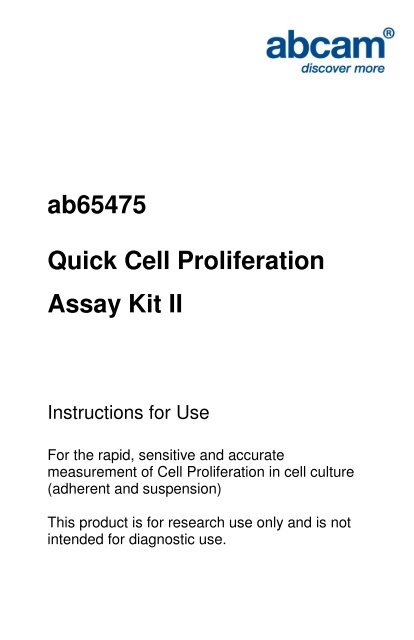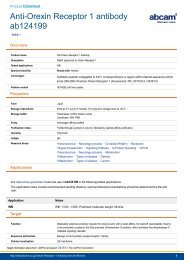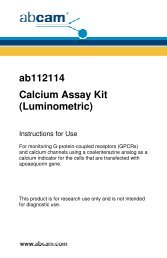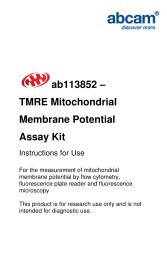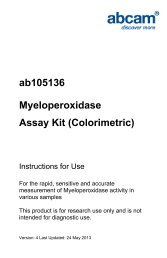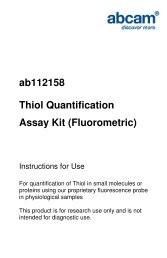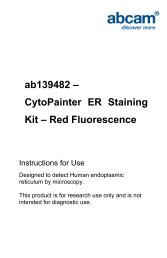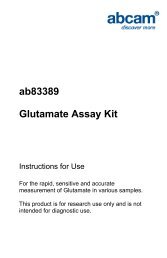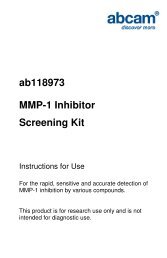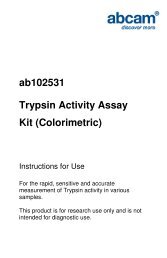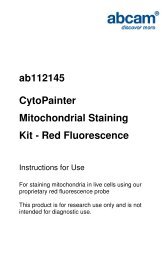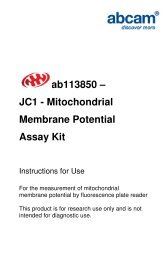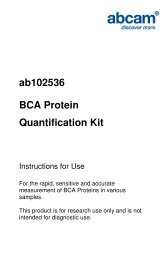ab65475 Quick Cell Proliferation Assay Kit II - Abcam
ab65475 Quick Cell Proliferation Assay Kit II - Abcam
ab65475 Quick Cell Proliferation Assay Kit II - Abcam
- No tags were found...
You also want an ePaper? Increase the reach of your titles
YUMPU automatically turns print PDFs into web optimized ePapers that Google loves.
<strong>ab65475</strong><strong>Quick</strong> <strong>Cell</strong> <strong>Proliferation</strong><strong>Assay</strong> <strong>Kit</strong> <strong>II</strong>Instructions for UseFor the rapid, sensitive and accuratemeasurement of <strong>Cell</strong> <strong>Proliferation</strong> in cell culture(adherent and suspension)This product is for research use only and is notintended for diagnostic use.
Table of Contents1. Overview 32. Protocol Summary 43. Components and Storage 54. <strong>Assay</strong> Protocol 72
1. Overview<strong>Abcam</strong>’s <strong>Quick</strong> <strong>Cell</strong> <strong>Proliferation</strong> <strong>Assay</strong> <strong>Kit</strong> <strong>II</strong> provides by far theeasiest and most sensitive means for quantifying cell proliferationand viability.The assay is based on the cleavage of the tetrazolium salt toformazan by cellular mitochondrial dehydrogenase. The amount ofthe dye generated by activity of dehydrogenase is directlyproportional to the number of living cells. The formazan dyeproduced by viable cells can be quantified by multi-wellspectrophotometer (microtiter plate reader) by measuring theabsorbance of the dye solution at 440 nm.The assay can be used for measurement of cell proliferation inresponse to growth factors, cytokines, mitogens, and nutrients, etc. Itcan also be used for the analysis of cytotoxic compounds likeanticancer drugs and many other toxic agents and pharmaceuticalcompounds. The new method is so simple, just add-and-read,requiring no washing, no harvesting, and no solubilization steps. It isfaster, stable, and more sensitive than MTT, XTT, MTS basedassays. The assay correlates well with the [3H]-thymidineincorporation assay.3
2. Protocol SummaryCulture <strong>Cell</strong>sAdd WST SolutionIncubate <strong>Cell</strong>sShake ThoroughlyMeasure Absorbance4
3. Components and StorageA. <strong>Kit</strong> ComponentsItemQuantity(500 assays)Quantity(2500 assays)WST Reagent (Lyophilized) 1 vial 1 vialElectro Coupling Solution (ECS) 5 ml 25 mlStop Solution 5 ml 25 ml* Store kit at -20°C.WST REAGENT: Dissolve the lyophilized WST reagent into5 ml/25 ml Electro Coupling Solution (ECS), aliquot the solution (1 mlis sufficient for one 96-well plate assay) and store at -20°C.The WST Solution is stable for 1 year at -20°C and up to 6 months at+4°C. Protect from light. Avoid repeated freeze-thaw. Repeatedfreeze-thaw may increase background.5
B. Additional Materials Required• Microcentrifuge• Pipettes and pipette tips• Multi-well spectrophotometer (microtiter plate reader)• 96 well plate• Orbital shaker6
4. <strong>Assay</strong> Protocol1. Culture cells (0.1-5x10 4 /well) in a 96-well microtiter plate in a finalvolume of 100 µl/well culture medium in the absence or presenceof various amounts of the factors tested.For toxicity assays, use more cells to start with (e.g., 5x10 4 -x10 5cells/well).The optimal cell number used for the assay may vary among celltypes. For best results, it is recommended to add variousnumbers of cells in your initial assay to determine the optimal cellnumber and the developing time to be used.2. Incubate cells for 24-96 hours.3. Add 10 µl per well WST Solution to each well. Be careful not tointroduce bubbles to the wells.4. Incubate the cells for 0.5-4 hours in standard culture conditions.5. Shake thoroughly for 1 min. Measure the absorbance of thetreated and untreated samples using a microtiter plate reader at420-480 nm according to the filters available for the plate reader.The reference wavelength should be ~650nm.7
Notes:a) Use the same amount of culture medium and WST reagent in anempty well as a blank position for the microtiter plate reader.b) The plate can be repeatedly read many times until desired OD isreached.c) The reaction can be stopped by adding 10 µl of the Stop Solutioninto each well, mix well, and the plate can be read within48 hours. Protect from light and prevent medium evaporation.d) Phenol Red in culture medium does not significantly interfere withthe assay.e) WST shows very low toxicity and it does not stain the cells. Thus,the same cells can be used for other tests after WST assay.For further technical questions please do not hesitate tocontact us by email (technical@abcam.com) or phone (select“contact us” on www.abcam.com for the phone number foryour region).8
UK, EU and ROWEmail: technical@abcam.comTel: +44 (0)1223 696000www.abcam.comUS, Canada and Latin AmericaEmail: us.technical@abcam.comTel: 888-77-ABCAM (22226)www.abcam.comChina and Asia PacificEmail: hk.technical@abcam.comTel: 108008523689 ( 中 國 聯 通 )www.abcam.cnJapanEmail: technical@abcam.co.jpTel: +81-(0)3-6231-0940www.abcam.co.jpCopyright © 2012 <strong>Abcam</strong>, All Rights Reserved. The <strong>Abcam</strong> logo is a registered trademark. 11All information / detail is correct at time of going to print.


